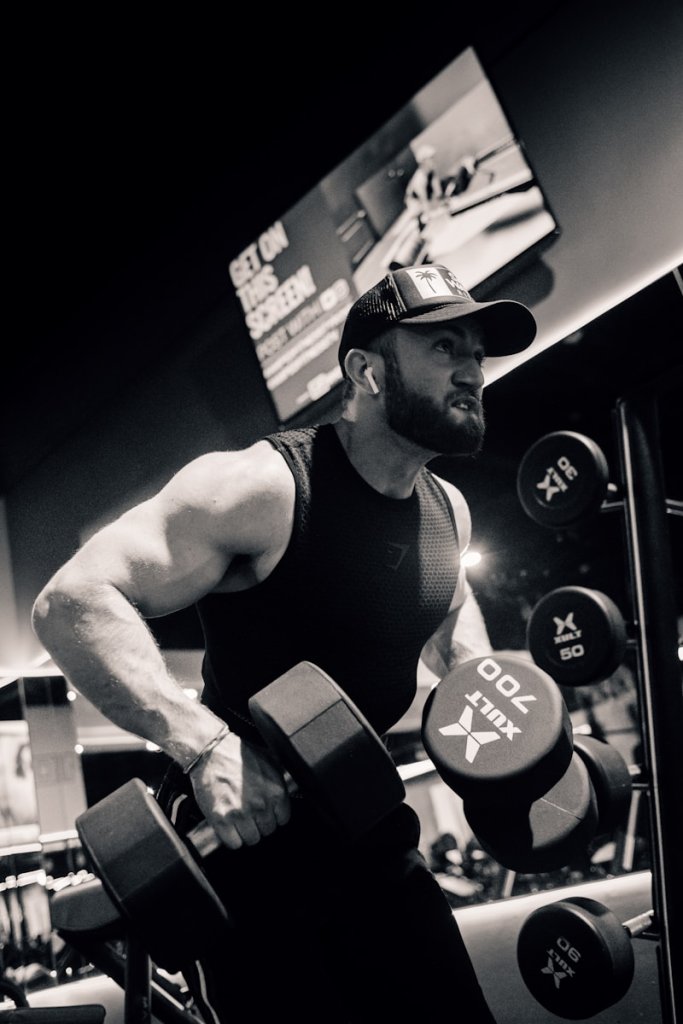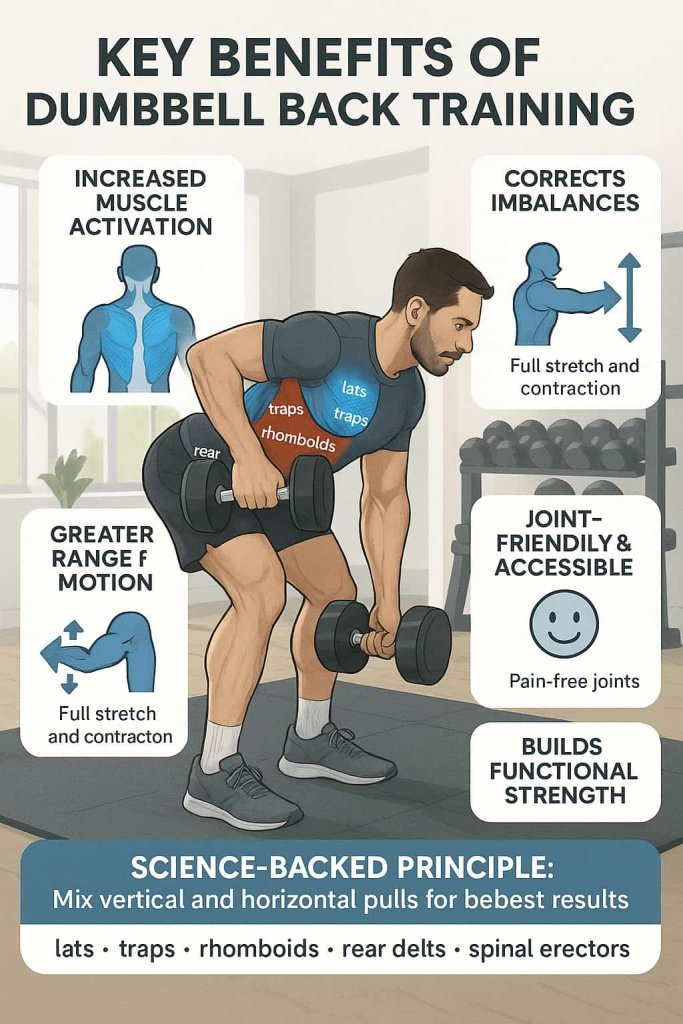Dumbbell back exercises for mass and strength can build an impressive back at any fitness level—even if you only have dumbbells at home or in the gym. Research and top trainers agree: training your back with dumbbells not only increases muscle mass, but also corrects imbalances and strengthens stabilizer muscles for better performance and posture.

Why is this important? A strong back is the cornerstone of a powerful, balanced physique. It supports every upper-body movement, prevents injury, and creates the “V-taper” look most people want. This guide answers all your back-training questions, outlines the best dumbbell moves for each part of your back, and gives practical programming tips for real results.
- Master the top 16 dumbbell back exercises
- Use science-backed rep ranges and technique cues
- Follow a proven workout plan for size and strength
- Apply trainer tips to stay safe and see faster gains
For official exercise technique demos, check the ACE Exercise Library – Back.
Why Dumbbell Back Training Works (Science & Trainer Insights)

Dumbbells offer unique advantages for back development, confirmed by sports science and certified trainers:
- Increased muscle activation: Research shows dumbbell rows, flyes, and pullovers activate more stabilizer muscles than machines or barbells, helping build a thicker, wider back.
- Corrects imbalances: Working each arm separately prevents one side from dominating, which is common with barbells.
- Greater range of motion: You get a deeper stretch and stronger contraction, key for muscle growth.
- Accessible and joint-friendly: Most people find dumbbells more comfortable, with less joint stress.
- Functional strength: Many exercises train your core and posture, protecting your spine in daily life.
Science-Backed Principle:
To maximize back muscle size, use a mix of vertical pulls, horizontal pulls, and isolation moves—targeting lats, traps, rhomboids, rear delts, and spinal erectors (PubMed, 2023).
Training Guidelines for Mass & Strength
- Reps: 8–12 per set is best for muscle growth (hypertrophy). 5–8 reps for strength, 12–15 reps for endurance.
- Sets: 3–5 per exercise.
- Frequency: Train back 2–3 times per week, allowing 48 hours between sessions.
- Tempo: Lower the weight for 2–3 seconds (eccentric phase), lift with control.
- Progression: Increase weight, reps, or sets every 1–2 weeks for ongoing progress.
- Form: Keep spine neutral, squeeze shoulder blades, avoid swinging or momentum.
For further reading, see NASM Hypertrophy Guidelines.
The 16 Best Dumbbell Back Exercises (Trainer-Approved Breakdown)
1. Dumbbell Bent-Over Row
Muscles Worked: Lats, rhomboids, traps, rear delts, lower back
Benefits: The gold standard for building both back width and thickness.
How to Do It:
- Stand with feet hip-width apart, knees slightly bent.
- Hold a dumbbell in each hand, hinge at the hips until your torso is about 45° to the ground.
- Let arms hang down, palms facing in.
- Row the weights up toward your lower ribs, squeezing shoulder blades together at the top.
- Lower with control.
Trainer Tip: Keep your elbows close to your body and avoid rounding your lower back.
2. Single-Arm Dumbbell Row
Muscles Worked: Lats, mid-back, core
Benefits: Unilateral movement corrects imbalances and allows deep lat activation.
How to Do It:
- Place one knee and one hand on a bench for support.
- Hold a dumbbell in the opposite hand.
- Keep your torso flat and pull the dumbbell towards your hip, keeping your elbow tight.
- Pause, then lower slowly.
Trainer Tip: Don’t twist or rotate your torso—your chest should face the bench the whole time.
3. Incline Bench Dumbbell Row
Muscles Worked: Lats, lower traps, mid-back
Benefits: Reduces lower back strain; you can lift heavier with better form.
How to Do It:
- Set a bench to a 30–45° incline.
- Lie face down, chest on the bench, holding dumbbells.
- Pull weights to your sides, squeezing your shoulder blades.
- Lower with control.
Trainer Tip: Focus on pulling “back and down” to fully engage the lower traps.
4. Renegade Row
Muscles Worked: Lats, arms, core, chest
Benefits: Combines back training with anti-rotation core work.
How to Do It:
- Get into a push-up plank with a dumbbell in each hand.
- Row one dumbbell up to your ribs, stabilizing with the other arm.
- Alternate sides.
Trainer Tip: Keep hips square to the floor and avoid rocking.
5. Dumbbell Pullover
Muscles Worked: Lats, chest, triceps
Benefits: Stretches and grows the lats, expands the ribcage, opens the chest.
How to Do It:
- Lie across a bench with only your upper back supported.
- Hold a dumbbell with both hands above your chest.
- Lower the weight behind your head, keeping arms slightly bent.
- Pull it back up over your chest.
Trainer Tip: Move slowly—don’t let the weight drop behind you uncontrolled.
6. Dumbbell Reverse Fly
Muscles Worked: Rear delts, upper back
Benefits: Improves posture, scapular stability, and upper back width.
How to Do It:
- Hinge at the hips with arms hanging down.
- With a slight bend in your elbows, raise dumbbells out to the side.
- Squeeze shoulder blades together.
Trainer Tip: Don’t use momentum—pause at the top for max benefit.
7. Wide-Grip Dumbbell Row (Elbows Out)
Muscles Worked: Rear delts, upper traps, rhomboids
Benefits: Targets the upper back and helps balance heavy pressing movements.
How to Do It:
- Perform a bent-over row, but flare elbows out to about 90°.
Trainer Tip: Focus on the upper back muscles—don’t pull with your biceps.
8. Farmer’s Carry (Heavy Dumbbells)
Muscles Worked: Traps, grip, forearms, core, upper back
Benefits: Builds trap mass, grip strength, and full-back endurance.
How to Do It:
- Stand tall, holding heavy dumbbells at your sides.
- Walk forward for a set distance or time.
Trainer Tip: Keep shoulders back and down, chest proud.
9. Dumbbell Deadlift
Muscles Worked: Lower back, glutes, hamstrings, upper back
Benefits: Full posterior chain development—strength and size.
How to Do It:
- Stand with feet shoulder-width, dumbbells in front of thighs.
- Hinge at hips, keeping back flat.
- Lower dumbbells just past knees, then return to standing, squeezing glutes.
Trainer Tip: Don’t round your back; focus on hip drive.
10. Single-Leg Dumbbell Row
Muscles Worked: Lats, glutes, stabilizers
Benefits: Challenges balance, stability, and hits lats uniquely.
How to Do It:
- Stand on one leg, hinge at the hips, other leg extended behind.
- Row dumbbell with one arm.
Trainer Tip: Move slow; focus on form over weight.
11. Kneeling Single-Arm Row with Pause
Muscles Worked: Lats, core
Benefits: Adding a pause increases time under tension, boosting muscle growth.
How to Do It:
- Kneel with one hand and one knee on a bench.
- Row the dumbbell up and pause for 2 seconds at the top.
Trainer Tip: Keep your abs tight to stabilize your torso.
12. Chest-Supported Reverse Fly
Muscles Worked: Rear delts, rhomboids
Benefits: Eliminates momentum, isolates upper back muscles.
How to Do It:
- Lie face down on an incline bench.
- Perform reverse fly by raising arms out to the sides.
Trainer Tip: Don’t let chest leave the bench; focus on squeezing shoulder blades.
13. Superset: Heavy Row + Light Reverse Fly
How to Do It:
- Perform 8 reps of heavy bent-over rows.
- Immediately switch to 15 reps of lighter reverse flyes.
Benefits: Trains both power and muscular endurance, hits both big and small back muscles in one set.
14. Tempo Row (Slow Eccentric)
How to Do It:
- Perform standard rows, but lower the dumbbells slowly—3–4 seconds per rep.
Benefits: Increases muscle tension and damage (a key driver of hypertrophy).
Trainer Tip: Use lighter weights—quality over quantity.
15. Bird-Dog Row
Muscles Worked: Lats, core, glutes
Benefits: Improves core stability and deep back strength.
How to Do It:
- Get in bird-dog position (one hand and opposite knee on a bench).
- Row dumbbell with the free arm.
- Switch sides.
Trainer Tip: Keep your body steady—don’t let hips rotate.
16. Dumbbell Shrug
Muscles Worked: Traps, upper back
Benefits: Directly targets and thickens upper traps.
How to Do It:
- Stand tall, arms at sides.
- Shrug shoulders straight up, then lower under control.
Trainer Tip: Don’t roll your shoulders—move straight up and down for joint safety.
How to Program These Dumbbell Back Exercises
- Beginners: Pick 3–5 moves, 3 sets of 10–15 reps, 2–3 times per week.
- Intermediates: Add more variations, tempo work, and supersets.
- Advanced: Incorporate unilateral, balance, and slow eccentric work, plus heavier weights.
Pro Tips for Maximum Back Gains:
- Pair with chest and core exercises for a balanced program.
- Focus on controlled movement, not momentum.
- Squeeze your back muscles at the top of every row.
- Gradually increase weights as your form improves.
- Combine vertical (pullover, shrugs) and horizontal (row, reverse fly) patterns for complete development.
Sample Dumbbell Back Workout Plan
| Exercise | Sets x Reps | Rest |
|---|---|---|
| Bent-Over Row | 4 x 10 | 60s |
| Single-Arm Row | 3 x 12/side | 60s |
| Incline Row | 3 x 10 | 60s |
| Reverse Fly | 3 x 15 | 45s |
| Farmer’s Carry | 3 x 40m | 60s |
Tip: Rotate exercises and adjust reps for strength (lower) or endurance (higher).
Pro Tips for Fast Progress (Trainer Insights)
- Form first, weight second: Quality reps beat heavy, sloppy reps for both safety and growth.
- Film your set: Check your back angle, shoulder position, and avoid using your arms more than your back.
- Progressive overload: Track your weights and reps. Aim to improve weekly, even by 1 rep or 2.5 lbs.
- Nutrition: Get 1.6–2.2g protein per kg bodyweight per day (NIH, 2024).
- Rest and recover: Back muscles need 48 hours rest between hard sessions.
Frequently Asked Questions (FAQ)
Can dumbbells build a big, strong back?
Yes! Science shows that with progressive overload, dumbbells activate as much or more back muscle than barbells for most exercises.
How often should I train my back?
2–3x per week is ideal for muscle growth and strength (PubMed, 2023).
Which weights should I use?
Use heavy weights (6–8 reps) for compound moves like rows and deadlifts, lighter weights (12–15 reps) for isolation exercises like flyes.
Conclusion
A powerful, V-shaped back is within your reach—no fancy gym equipment needed. Use these 16 science-backed dumbbell exercises to maximize muscle mass, strength, and injury prevention. Stay consistent, focus on form, and progress week by week for the best results.
